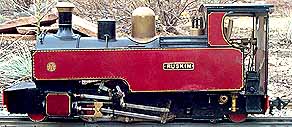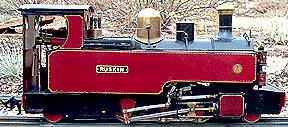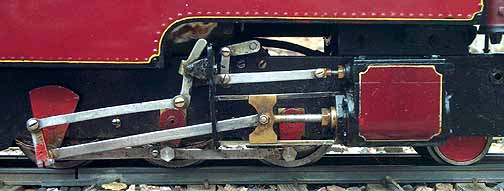
Back to Loco of the Month homepage
Back to Sidestreet Bannerworks
.
March 2004
Cyril Clarke's Ruskin
by Marc Horovitz

Ruskin is modeled after Russell, a 2-6-2T locomotive that runs on the Welsh Highland Railway (WHR). Russell was built in 1906 by Hunslet for the Portmadoc, Beddgelert & South Snowdon Railway (which never opened). It was acquired by the WHR in 1922 and ran there until the railway closed in 1937. Russell was requisitioned for war work in 1942 and, after the war, had an industrial job until it was retired in 1953. The engine was purchased by a preservation society and moved to the Talyllyn Railway in Towyn, Wales, for a while. It was ultimately fully restored and was reacquired by the WHR, where it resides today.
The model
The model being reviewed this time was scratchbuilt by Cyril Clarke of Great Britain. (To see another of Mr. Clarke's locomotives, click here.) It is nicely made and was originally radio controlled. It has since been converted to manual control. Both the back of the cab and the roof can be removed for easy access to the controls.
The backhead is fully configured and includes a pressure gauge, water glass with blowdown, and a check valve connected to the ENOTS filler valve on the left side, beneath the cab. A piece of silicon tubing prominent in the cab is the filler line for the alcohol tank under the footplate. This tank is equipped with an overflow.
The boiler is a large pot with porcupine quills in the four-wick fire. Valve gear is abbreviated Walschaerts, controlled from a reversing lever on the left side of the cab.
The engine is nicely detailed, with an air compressor on the right-hand side tank and appropriate pipework. The dummy side tanks are filled with insulation to help keep the engine cool.
A hand-built model has an entirely different character than a commercially-made one. Attention to detail (such as dummy springs on the axle keeper plates), slight imperfections, and ingenious solutions to problems all help to give a handbuilt model unique charm.
The run
Weather on the run day was cold (in the mid 30s), rainy, and gloomy -- in short, a perfect day for running an alcohol-fired engine. After oiling all round and supplying the beast with all of its vital fluids in the regulation manner, Ruskin was placed on the track and its four wicks set alight. In less than 10 minutes pressure was up. It didn't stop at 40psi, though -- it just kept coming. I suspected something was amiss with the safety valve, so gave it a tweak with a pair of pliers. Yup, it was stuck. Steam erupted in great volumes until the regular blow-off pressure of 40 pounds had been reached.
The safety valve on this engine is unusual in that its works are all on the outside. This functions just as well as the more traditional kind, but has the added feature of being more visually interesting. This particular one makes a nice razzberry noise when it lets go, much like an Archangel valve.
With pressure up, I opened the throttle and the engine glided smoothly away without even a push. It ran on and on through the inclement weather, the safety valve emitting the occasional noise. Clouds of steam poured from the stack and hung in the damp air. Wonderful! The fuel was topped up two or three times during the run. With the ENOTS valve, the engine could have been kept in steam all day. However, the driver was getting cold, so the fire was allowed to die, the engine was stopped, and the boiler was blown down, producing further gales of atmospherics. All in all, this was an ideal run, topped off with a cup of cocoa in the warm confines of the workshop.
.
|
|
|
| Builder | Cyril Clarke (Great Britain) |
| Date built | Early 1990s (?) |
| Gauge | 32mm |
| Scale | 16mm |
| Boiler | Pot with quills |
| Fittings | Safety valve, pressure gauge, water glass, blowdown, throttle, ENOTS filler valve |
| Fuel | Alcohol |
| Blow-off pressure | 40 psi |
| Cylinders | Two, double-acting D-valve |
| Reversing gear | Abbreviated Walschaerts, controlled by a lever in cab |
| Lubricator | Displacement, with drain |
| Dimensions | Length, 12-3/8"; width, 4-1/8"; height, 5-7/8" |


Ruskin nicely captures the lines and feeling of the prototype Russell.
.
The silicon tube in front of the pressure gauge is the filler tube for the fuel tank.
.
.
.
.



Above: The valve gear is made of parts cut from steel plate. The locomotive is painted in (current) prototypical colors.
Far right: The underside of the engine is pretty straightforward. Four wick tubes provide heat for the boiler. Hidden inside the firebox are quills built into the pot boiler to help disperse and maximize the heat. The tube extending to the right at the bottom of the picture is the overflow line from the alcohol tank. The ENOTS filler valve is just to the right of it (partially obscured) and the lubricator drain can be seen just below the ENOTS valve.
Right: Ruskin's external safety valve.
.


Back to Loco of the Month home page
Back to Sidestreet Bannerworks home page
This page and its contents
Copyright Sidestreet Bannerworks, 2004